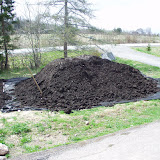 |
| MFFY Photo Gallery |
FROM A SHABBY LAWN TO ... well, it still looks kind of shabby. But my forlorn front yard is coming along, really it is. Click on the photo to see a web album of photos from summer of 2005, when the pile of compost was delivered, to spring of 2007, when I weeded for the first time. Yes, that's right--for the first time. I don't recommend letting the weeding go for so long (this area would probably be looking a lot better if I had weeded annually or even biannually), but I did almost no weeding for two years, from the time the area was planted in 2005 until this spring. Thus far the labor to install natives in this area has consisted of: begging cardboard from a local merchant, spreading cardboard and covering it with compost, collecting native plants, planting natives in the compost, watering the natives (first year after planting), and one extended weeding effort, on which I've probably spent a few hours a day for the last month. The only out-of-pocket cost for this project has about $200 for a load of compost plus the cost of purchasing a few native shrubs.

3 comments:
I've always wanted to ask a good gardener if not weeding might work in some situations to reduce weeds. Since so many of that type of plant grows in disturbed soil, doesn't weeding make the ground more susceptible to weeds?
This is a really good question. You're right that stirring up the soil tends to encourage weeds. This is not only because any bare or disturbed soil is a good place for seedlings to take root but also because stirring up soil brings weed seeds to the surface, where they germinate. This is why my first step in preparing soil for planting is to cover it with cardboard and a layer of (weed-free) mulch. This buries the weed seeds that are already in the soil even deeper, so they become that much less of a problem. Unfortunately after that you still do get weeds: some, such as dandelion, can get through the cardboard, and others blow in. It would be great if not weeding could actually reduce these weeds in some way, but the only way that would work would be if you were willing to let your entire property be taken over by a solid carpet of weeds. If that's not an option, then you have to weed for the first few years. In fact, you should weed quite aggressively for the first few years, while the plants you do want are knitting together. The mistake I made was that I didn't weed in the second year--this means that now I'm dealing with not just a lot of weeds but also with a lot of weed seeds. If I had weeded more aggressively last year, I would probably have better coverage from the native plantings by now, and I could be tapering off my weeding instead of having to step it up. Heavy weeding will continue to be necessary until I have a thick cover of native plants to suppress any weeds that try to gain a foothold.
The other option, of course, is to declare your weeds as native plants or groundcovers. :-)
Yes, I know, dandelions aren't native, and neither are some others that we take for granted...but it's worked for me and brought critical gardeners to a complete halt. "Oh! Native plants! How nice." Tee hee.
Post a Comment